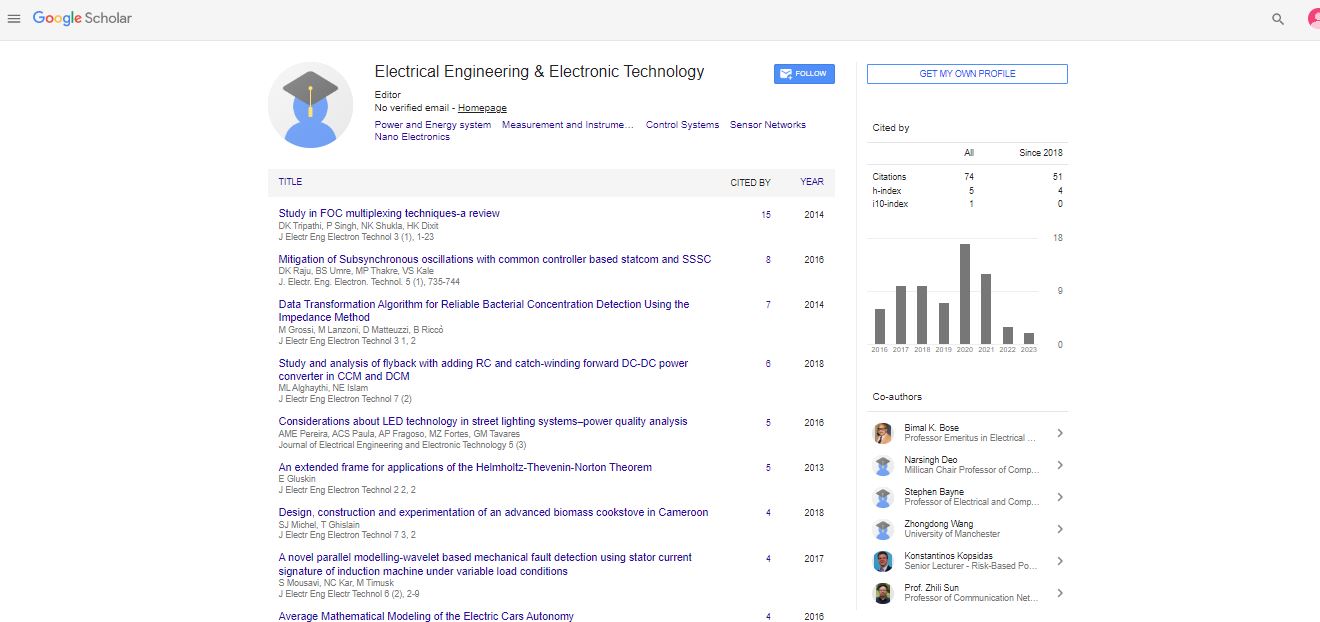Editorial, J Electr Eng Electron Technol Vol: 14 Issue: -1
Embedded Systems: The Invisible Intelligence Behind Modern Technology
Chris Thomson*
Department of Electrical Engineering, Politecnico di Milano, Italy
- *Corresponding Author:
- Chris Thomson
Department of Electrical Engineering, Politecnico di Milano, Italy
E-mail: chris945@gmail.com
Received: 01-Jan-2025, Manuscript No. jeeet-25-170065; Editor assigned: 4-Jan-2025, Pre-QC No. jeeet-25-170065 (PQ); Reviewed: 18-Jan-2025, QC No. jeeet-25-170065; Revised: 25-Jan-2025, Manuscript No. jeeet-25-170065 (R); Published: 30-Jan-2025, DOI: 10.4172/2325-9838.1000996
Citation: Chris T (2025) Embedded Systems: The Invisible Intelligence Behind Modern Technology. J Electr Eng Electron Technol 14: 996
Introduction
An embedded system is a specialized computing system that performs dedicated functions or tasks within a larger system. Unlike general-purpose computers, embedded systems are designed for specific applications and are often integrated into devices where users may not even realize a computer is at work. They combine hardware and software to operate with high efficiency, reliability, and real-time performance. From household appliances and medical equipment to automobiles and industrial machines, embedded systems are at the heart of countless technologies that define modern life [1].
Discussion
Embedded systems consist of microcontrollers or microprocessors that execute program code written for a particular task. These systems also include memory, input/output interfaces, and sometimes operating systems, depending on complexity. Embedded software is typically developed in programming languages like C or C++, and in more complex systems, real-time operating systems (RTOS) are used to manage tasks with precise timing requirements [2].
There are different types of embedded systems based on performance and functionality:
- Standalone Embedded Systems: Operate independently without needing a host system. Examples include digital watches, MP3 players, and microwave ovens [3].
- Real-Time Embedded Systems: Respond to inputs or events within a strict time constraint. These are used in safety-critical applications like airbag controllers, medical devices, and industrial robots.
- Networked Embedded Systems: Communicate with other devices or systems through wired or wireless networks. Examples include smart home devices and IoT-based sensors [4].
- Mobile Embedded Systems: Found in portable devices such as smartphones, tablets, and GPS trackers, where both power efficiency and performance are essential.
The main advantages of embedded systems include low cost, compact size, high efficiency, and reliability. Since they are built for specific functions, they can be optimized for performance and power consumption. This makes them ideal for battery-powered devices and applications where space and resources are limited [5].
Embedded systems are critical in various industries:
- In automotive, they control everything from engine performance and braking systems to entertainment and navigation.
- In healthcare, embedded systems are used in medical monitoring devices, imaging systems, and automated diagnostic tools.
- In consumer electronics, embedded systems are the brains behind smartphones, smart TVs, and digital cameras.
- In industrial automation, they manage robotics, process control systems, and safety mechanisms.
As the world embraces the Internet of Things (IoT), embedded systems are becoming even more powerful and interconnected. The ability to collect data, process it locally, and communicate with other devices or cloud platforms has opened up new possibilities in smart cities, agriculture, transportation, and more.
Conclusion
Embedded systems are the silent engines of today’s digital age, providing intelligence and control to devices and systems across all sectors. Their application-specific design allows for optimized performance, energy efficiency, and real-time response. As technology continues to advance, embedded systems will grow more sophisticated, playing a central role in innovation and the development of smarter, more connected environments. Understanding embedded systems is essential for engineers, developers, and technologists driving the future of intelligent automation and IoT.
REFERENCES
- Grace S, Higgs J (2010). Integrative medicine: enhancing quality in primary health care. J Altern Complement Med. 16: 945â??950.
- Templeman K, Robinson A (2011). Integrative medicine models in contemporary primary health care. Complement Ther Med. 19: 84-92.
- Lake J, Helgason C, Sarris J (2012). Integrative mental health (IMH): paradigm, research, and clinical practice. The Journal of Science and Healing. 8: 50-57.
- Pengpid S, Peltzer K (2018). Utilization of traditional and complementary medicine in Indonesia: results of a national survey in 2014-15. Complement Ther Clin Pract. 33: 156-163.
- Stepleman LM, Penwell-Waines L, Valvano A (2015). Integrated care psychologists and their role in patient transition from medical to psychiatric specialty care settings: a conceptual model. Health Psychol Behav Med. 3: 154-168.
Indexed at, Google scholar, Cross ref
Indexed at, Google scholar, Cross ref
Indexed at, Google scholar, Cross ref
Indexed at, Google scholar, Cross ref
 Spanish
Spanish  Chinese
Chinese  Russian
Russian  German
German  French
French  Japanese
Japanese  Portuguese
Portuguese  Hindi
Hindi 
